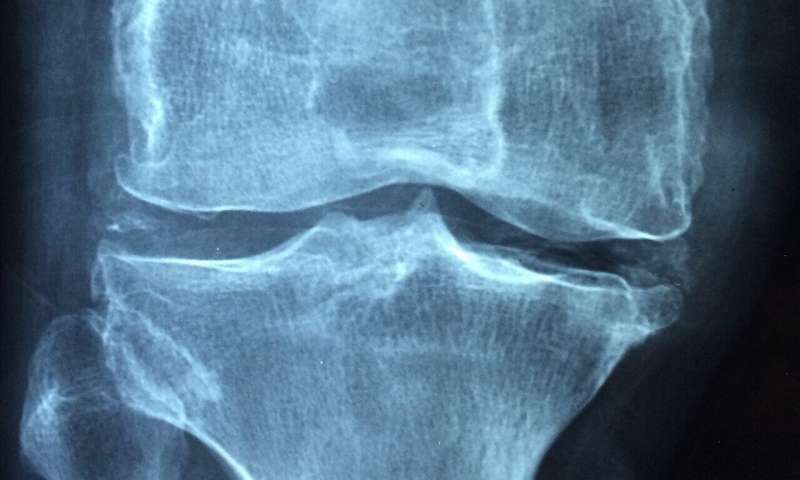Credit: CC0 Public Domain
A new study reveals that many older men who experience a fracture are still underdiagnosed with and undertreated for osteoporosis. Details of the study was presented at ACR Convergence, the American College Rheumatology's annual meeting (ABSTRACT #0533).
Osteoporosis is a common condition that results from a loss of bone mass, measured as bone density, and from a change in bone structure. Bone is living tissue that is in a constant state of regeneration. By their mid-30s, most people begin to slowly lose more bone than can be replaced. As a result, bones become thinner and weaker in structure. This accelerates in women at the time of the menopause. In men, bone loss usually becomes more of an issue around age 70.
Osteoporosis can cause significant burden upon patients, including physical symptoms, increased cost of healthcare and mortality. Approximately one quarter of patients with fractures are male, and emerging evidence suggests that men with osteoporotic fractures have worse outcomes than women. This new study looked at the baseline characteristics of male Medicare patients who have had an osteoporosis-related fracture. Addressing the absence or gap in undergoing bone density screening was the major reason for the study.
"Men are typically not part of routinely recommended screening with DXA and so they are both underdiagnosed and undertreated. While many comorbidities (i.e., cardiovascular disease) are commonly recognized and treated in men, sometimes even more than women, osteoporosis is not one of them. Even post fracture for major fractures like a hip, rates of treatment are disappointingly low, leaving men at risk for yet another fracture," says the study's co-author, Jeffrey Curtis, MD, MS, MPH, Professor of Medicine, Division of Clinical Immunology and Rheumatology at the University of Alabama at Birmingham. "There is also a lack of consistent guidelines for osteoporosis screening recommendations for men. Among women, the World Health Organization, American Association of Clinical Endocrinologists, United States Preventive Services Task Force, National Osteoporosis Foundation (NOF) and the American Academy of Family Physicians all recommend screening women over 65 years of age. However, among men, these groups do not make any recommendation at all, except for the NOF which recommends that all men over 70, and those between the ages of 50 to 69 who have risk factors, must be screened."
The researchers studied Medicare fee-for-service (FFS) beneficiaries who had a closed-fragility, or osteoporosis-related, fracture between January 2010 and September 2014. The inclusion criteria for the study included age 65 or older at the time of the index date, and continuous enrollment in Medicare FFS with medical and pharmacy benefits for a minimum of one year before the index date through at least one month after. Medicare beneficiaries were excluded if they died within 30 days of the index date. They also excluded patients with either Paget's disease or any malignancy, except non-melanoma skin cancer, at baseline. Patients were divided into four groups based on their diagnoses and/or treatment of osteoporosis at baseline. Osteoporosis diagnoses could be listed in any position on any medical claim.
The study included 9,876 Medicare beneficiaries. Sixty one percent were 75 or older and 90% were white. Fewer than 6% had a bone mineral density test with DXA, the standard test, in the two years before their fracture. Researchers also found that two-thirds (62.8%) of the patients had a history of musculoskeletal pain and nearly half (48.5%) had a history of opioid use one year prior to their fracture. The most common sites of fractures were the spine, hip and ankle. Of all patients with a qualifying fracture, about 92% did not have any claim for a DXA test or prescription claim for osteoporosis treatment in the two years prior to their index fracture. At baseline, 2.8% had been tested and not treated, 2.3% were treated but not tested, and only 2.1% were both tested and treated. The decline in the DXA scans in 2012 to 2014 was particularly high among men 75 years and older who are more likely to be at risk of fracture.
Based on the study's conclusions, earlier identification of high-risk male patients who might benefit from targeted osteoporosis screening and therapies would be of great value, the researchers say.
"There is a need for consistent osteoporosis screening recommendation in men," says Dr. Curtis. "Incorporation of these recommendations in quality-of-care measures for osteoporosis management and post-fracture care are warranted to improve health outcomes in this population. As for the next steps for research in this area, there is a need for better characterization of high-risk patients including existing comorbidities that may have shared etiology or risk factors that may enable earlier identification and treatment."
More information: acrabstracts.org/abstract/char … a-fragility-fracture
Provided by American College of Rheumatology





















